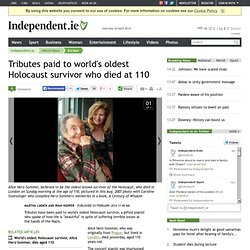

Behind the Picture: Joseph Goebbels Glares at the Camera, Geneva, 1933. The unsettling image of the Third Reich’s propaganda minister, Joseph Goebbels, glaring at photographer Alfred Eisenstaedt during a League of Nations conference in 1933 remains, 80 years later, one of the signature — and certainly one of the most unflattering — portraits ever made of any high-ranking Nazi figure. In the photo, Goebbels’s bony hands grip the arms of his chair. His tense posture transmits an almost palpable enmity. Hunched, wary, Goebbels resembles a seething homunculus. Bigotry in the USA: Photos From a Ku Klux Klan Initiation. According to a recent report by an Alabama-based civil rights group, the Southern Poverty Law Center, the number of extremist and anti-government “patriot” groups in the United States declined to around 2,000 in 2013 — after reaching an all-time high of almost 2,400 in 2012. Rather than a positive development, however, the SPLC notes that the lower number of hate groups might well be the result of the mainstreaming of far-right ideas into state legislation across the U.S.
But even if the number fluctuates by a few hundred year over year, the fact remains that Neo-Nazis, “Christian Identity” cults, white supremacist militias and other anti-Semitic, anti-foreign nativist groups exist in all 50 states. When it comes to extremist groups in America, of course, the longest-lived and most readily identifiable remains the Ku Klux Klan, which has been operating at varying degrees of influence and strength for close to 150 years. The more things change. . . . Walk on by Britain: Two little girls pretend to be lost in a busy shopping centre. So how many people stop to help? One. How many ignore their plight... 616! The two girls stood for an hour in a busy shopping arcadeThey were filmed as part of a social experiment for televisionAstonishingly, only one person stopped to help themEveryone else simply carried on going about their businessPassing couples even split apart to walk around the 'lost' girls By Sam Greenhill and Emine Sinmaz Published: 22:52 GMT, 23 March 2014 | Updated: 11:21 GMT, 24 March 2014 One little girl was clutching her favourite toy while her younger sister was sucking her thumb – and both looked utterly lost and forlorn.

Tributes paid to world's oldest Holocaust survivor who died at 110. 01 of 3 Martha Linden and Ryan Hooper – Published 24 February 2014 11:49 AM Alice Herz-Sommer, who was originally from Prague, but lived in London, died yesterday, aged 110 years old.

The concert pianist was imprisoned with her son for two years in the Theresienstadt concentration camp, a staging post for tens of thousands of inmates who were shipped off to their deaths in other camps. The Nazis imprisoned intellectuals, film makers, scientists and artists in the "show camp" where there were Red Cross inspections. Ms Herz-Sommer told the Guardian in 2006 that she gave more than 150 concerts there. "We had to play music because the Red Cross came and the Germans were trying to show what a good life we had," she told the newspaper. How To Be a Nonconformist: 22 Irreverent Illustrated Steps to Counterculture Cred from 1968. By Maria Popova “Avoid socks. They are a fatal giveaway of a phony nonconformist.” “Why do you have to be a nonconformist like everybody else?
,” James Thurber asked in the caption to a 1958 New Yorker cartoon depicting a woman fed up with her artist partner. It remains unknown whether the cartoon itself, or this cultural dismay shared by some of the era’s counterculture thinkers, inspired the 1968 gem How To Be a Nonconformist (public library) by Elissa Jane Karg. 0910look. Resistance heroine who led 7,000 men against the Nazis - Europe - World. Ms Wake, who has died in London just before her 99th birthday, was a New Zealander brought up in Australia.

She became a nurse, a journalist who interviewed Adolf Hitler, a wealthy French socialite, a British agent and a French resistance leader. She led 7,000 guerrilla fighters in battles against the Nazis in the northern Auvergne, just before the D-Day landings in 1944. On one occasion, she strangled an SS sentry with her bare hands. On another, she cycled 500 miles to replace lost codes. In June 1944, she led her fighters in an attack on the Gestapo headquarters at Montlucon in central France. Work began earlier this month on a feature film about Nancy Wake's life. "It was well-acted but in parts it was extremely stupid," she said. Ms Wake was also furious the TV series suggested she had had a love affair with one of her fellow fighters. Her "invisibility", according to French colleagues, was partly explained by her gender and her beauty.
Nancy became a nurse. After Kristallnacht: An Infamous Press Conference ‘Justifies’ Terror, 1938. The night of November 9-10, 1938, that came to be known as Kristallnacht (“Night of Broken Glass”) remains one of the most shocking eruptions of violence, outside of wartime, that modern Europe has ever seen.

In the course of several hours, as German paramilitary thugs and more than a few non-Jewish citizens rampaged through cities in Germany and Austria, destroying Jewish-owned stores, torching centuries-old synagogues and killing scores of innocents, the world was given its most graphic glimpse yet of the true, depraved nature of Hitler’s Reich.